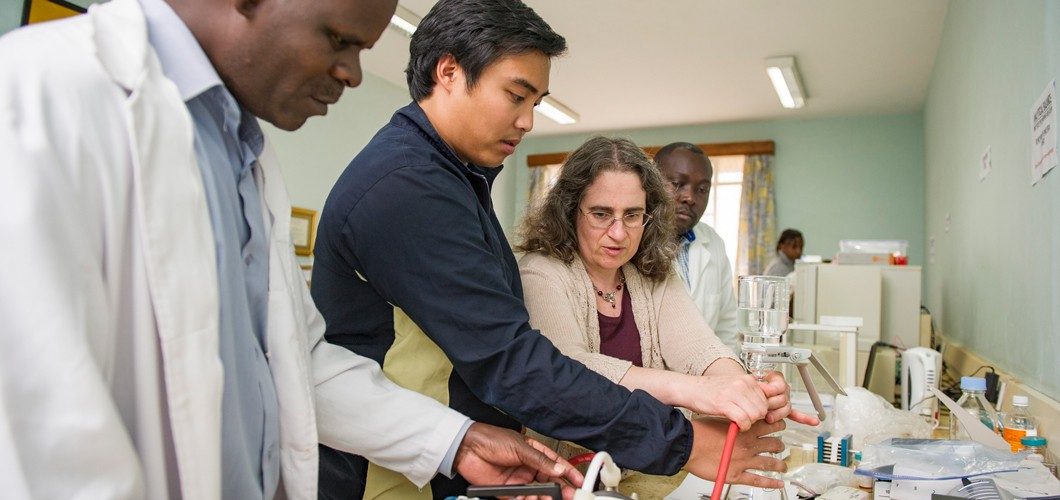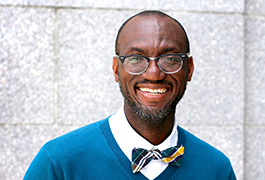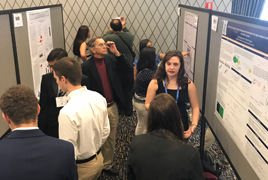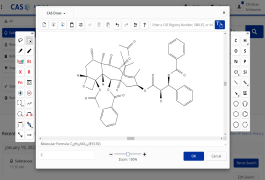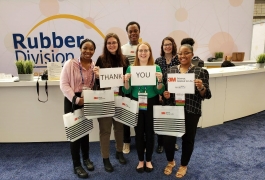Marya Lieberman Talks About Her Work in Identifying Counterfeit and Street Drugs
Many of us have dreamed about being an all-star: to have the thrill of being recognized as the ”best of the best,” to be honored with a trophy, to be featured on the Jumbotron® screen at a huge stadium. While college and professional athletes have this privilege, it is uncommon for chemistry professors—unless you are Marya Lieberman.
A professor of chemistry and biochemistry at University of Notre Dame in Indiana, Lieberman got her all-star moment during a timeout at a home football game against North Carolina State University. With the applause of 75,000 people, she was named to the All-Faculty Team for 2017 for her excellence in research, teaching, and service.
Her work in identifying fake and dangerous pharmaceuticals is definitely worth applause.
In some developing countries, there is a serious issue involving medicines that are either fake or of such poor quality that they are ineffective or even dangerous. Although no one knows exactly how large the problem is, experts agree it is serious. A recent article in The American Journal of Tropical Medicine and Hygiene called the prevalence of fake or poor-quality medicines a “global pandemic.”
Lieberman is on the front lines trying to combat the problem. Her lab has developed a tool they dub a “Paper Analytical Device” (PAD)—essentially a mini-chemistry lab on a paper card designed to enable health workers to test medicines in under four minutes without using complex or expensive machines. The PAD tests for counterfeit medicines as well as illegal drugs.
On Monday, August 26, at the ACS Fall 2019 National Meeting during the Core Student Program, she will give the Eminent Scientist lecture about the development of the PAD and how this tool’s new applications impact areas affected by illicit street drugs.
How did growing up in a college town in the Bay Area of California contribute to your interest in science?
It was very stimulating. My father was a professor at University of California, Berkeley, and our high school allowed us to take classes at the university. One of the courses I took was cell biology. That led to an opportunity to do some summer research, and I’ve been involved with science ever since.
You are dedicated to including undergraduate and graduate students in your research efforts. Is that because of your own early positive experiences?
Exactly. You can never pay back those valuable opportunities; all you can do is pay it forward. That is something I’ve tried to do with every opportunity. Our university is part of the National Science Foundation (NSF) Research Experiences for Undergraduates (REU) program. NSF funds a large number of research opportunities for undergraduate students in a range of academic disciplines. These types of experiences give students a chance to see how their learning works in the real world. My undergraduate and graduate students contribute positively to my work as well.
As graduate student Sarah Bliese puts it, this work “allows me to see how research can make an impact in the real world. You can read literature and statistics all day to help understand the way your research actually works, but then to have the opportunity to talk to people that will actually use that work in their daily lives is how you keep pushing through the challenges. Our research isn't about us going into a country to try and solve their problems for them, it's about giving them tools so they can do it themselves.”
How did you come up with the idea for the PAD?
In analytical chemistry, we are always working on a couple of basic goals. One is to make our tests and techniques more sensitive and accurate. Another is to create tests that are very specific for the substance we are trying to identify. The last goal is to make the tests more robust. By that I mean making tests that can be used anywhere, under a range of conditions, and by almost any worker, trained or not.
Once we got the chemistry right and had a card that worked, we tested it every way we could think of, including taking it to the lobby of our library on campus and having random students run the test. They taught us a lot about what could go wrong. We paid them with a candy bar for helping us out!
How the Paper Analytical Device (PAD) works
The PAD card starts with a piece of heavy chromatography paper made of pure cellulose fibers. The paper test cards contain reagents for a number of tests, each separated into its own lane between hydrophobic wax lines that are printed onto the paper. Then a color laser printer adds a QR code, color standards, and lane labels. After a quick bake to make the wax soak into the paper, the test cards are cut out. Finally, a robotic pipet machine places spots of different reagents into the lanes. After a visual inspection, the PADs are stamped with a serial number.
PADs work by simple chromatography. A sample of the drug in question is rubbed across the lanes of the PAD. The bottom of the card is then placed in water, allowing it to rise up the card by capillary action. When the water rises to sufficient level the results can be interpreted to indicate whether the medicine is likely real or fake.
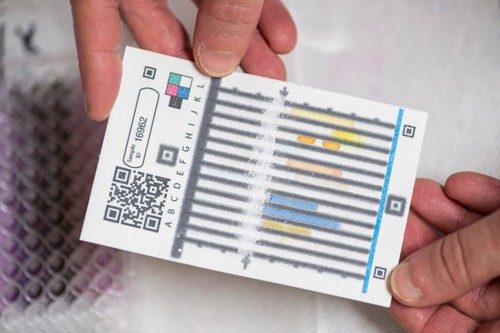
How many types of cards have you developed, and what can they detect?
For pharmaceuticals, we use one card design to evaluate over 60 types of medicines. We also have a card that's optimized for detecting illicit drugs and cutting agents, e.g., heroin, methamphetamine, procaine, cocaine, and lactose, which I'm going to talk about at the Eminent Scientist lecture.
What chemicals are in the cards to make the visible color changes that indicate adulterants?
The 12 lanes contain all the reagents needed to carry out tests for different chemicals and functional groups. For example, one lane contains copper(II) and a base; these materials give a characteristic forest-green color with any beta-lactam type antibiotic. That copper lane gives a different and distinctive color with metformin, which is a diabetes medication.
Another lane contains a series of spots of toluene sulfonic acid, sodium nitrite, p-nitroaniline, and sodium hydroxide, which generate a diazonium indicator to detect phenol groups found in drugs like acetaminophen or amoxicillin. Other lanes specialize in detecting inert fillers like maize meal using the venerable starch-iodine reaction, or they detect substitute drugs like acetaminophen that might be added to replace a more expensive medication. We're always looking for more chemistry to expand the types of drugs we can detect.
How are the results evaluated, and how do you collect the data?
Once the test is complete, the health worker takes a photo and sends it to our lab at Notre Dame for evaluation. We interpret the results on the card and send the results back to them. Last fall we trained 20 drug inspectors at the Tanzanian Food and Drug Authority and sent them 3,000 blinded samples of five medicines, about half of which were fakes; they read 93% of the samples correctly.
We are also working with a computer group here at the university to develop an artificial neural network computer system that could do this evaluation automatically. We’ve been working on creating simulations involving some positive and some negative card results to feed into the neural network to ”teach” it how to interpret the cards correctly. This would allow for a large capacity of collecting and disseminating data.
Computers are good at reading bar codes. Our current neural network program can read the Tanzania data with 96% accuracy, and we've put it onto raspberry pi minicomputers. One of them is in Bangladesh now, and our collaborators are gathering data on its field performance. As we gather more and more data, we can continue to work with local governments and give them an accurate picture as to the source and distribution of bogus or poor-quality medicines.
What do you hope happens as a result of your research?
These bad medicines come from a variety of sources. Sometimes they are outright fakes, made by people trying to make a profit by victimizing people. Other times they come from pharmaceutical companies that have poor manufacturing processes. In some cases, bad medicine is a result of how it is stored or transported, such as not keeping it refrigerated as necessary.
In the end, all we can do is let governments know when we find counterfeit or substandard medicine. Then it’s a matter for them to act on our information. We need to be realistic about what can be done. Many poor countries face huge problems on many fronts, and have meager resources to force change.
What do you like to do when you have a chance to relax?
One of my favorite things to do is to cook. I love to make meals for my student research assistants based on the cuisines of the countries we visited, such as Kenya, Malawi, Uganda, or Nepal. I try to collect recipes while I’m visiting and bring home ingredients needed to re-create dishes. This has led to some interesting encounters, like traveling through Germany with a couple of pounds of an unmarked white power. It was just corn flour, but it took some explaining to convince the security officers.
Lieberman is one of those individuals whose passion for chemistry runs deep and shows up in all parts of her life. At her wedding to fellow Notre Dame chemist Seth Brown, the couple performed a chemical demonstration, mixing mercury with sulfur. This ancient reaction goes back to the days of alchemy, when sulfur was considered the active male principle and mercury the female. The reaction of these two opposites creates a new compound, a symbol of a new life as a couple.
And while alchemy relied on a great deal of magical thinking, everything Marya Lieberman has accomplished has been based on great science and hard work. Talk about a golden touch—it’s enough to turn you into an all-star.

